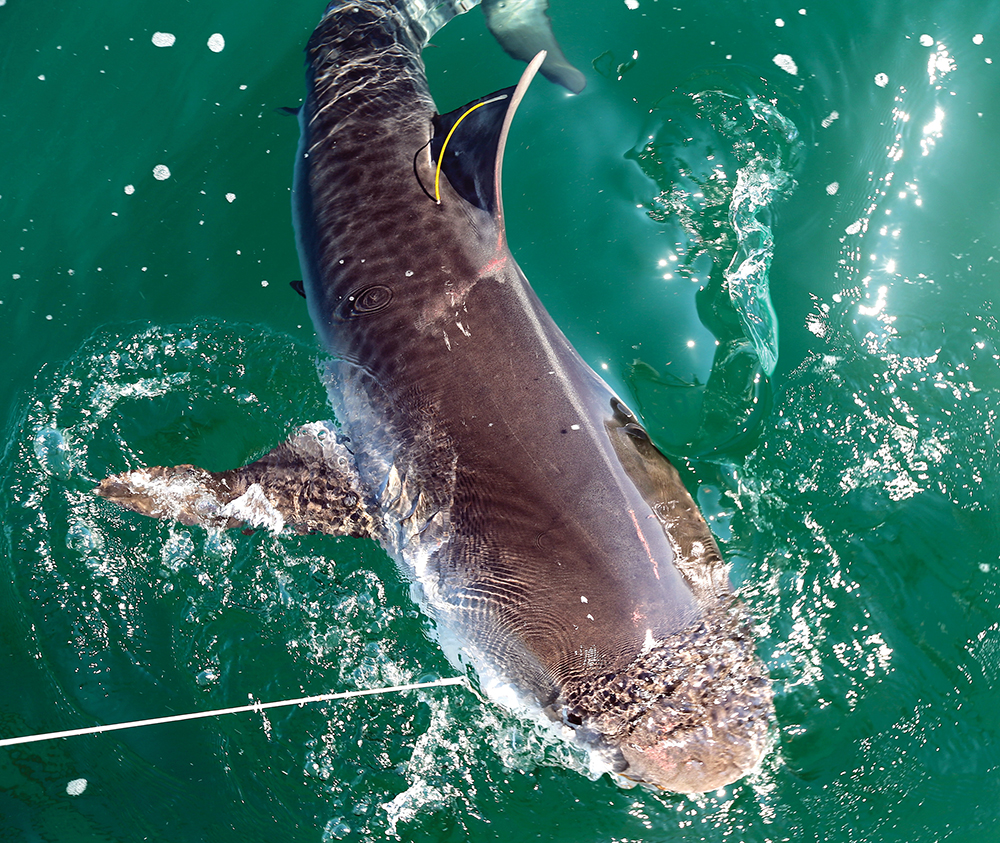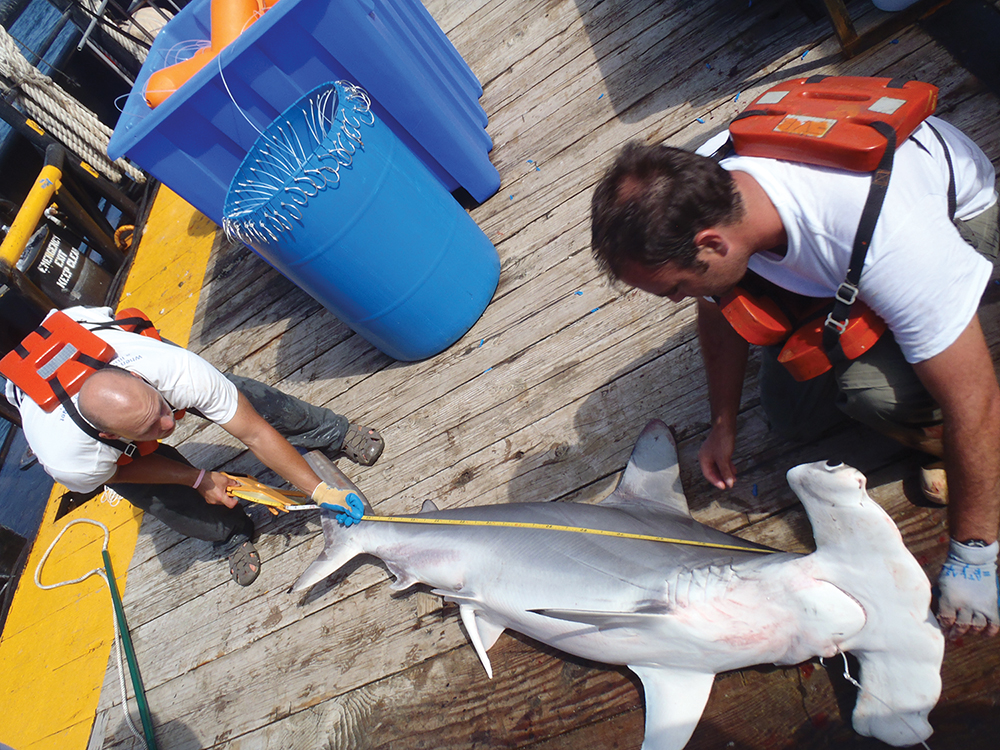By John N. Felsher
Many shark species swim Alabama waters, including some genuine maneaters. However, attacks rarely happen. “People would be surprised at how many species and the numbers of sharks off the Alabama coast,” says Dr. Sean P. Powers, a professor of marine sciences with the University of South Alabama and a scientist with the Dauphin Island Sea Lab. “Most sharks in Alabama waters are small and non-threatening to humans. Unprovoked shark attacks are very rare in Alabama, but in the past 20 years, we’ve seen an increase in attacks because more humans are going to the coast and we have more sharks now.”

Photo by David Hay Jones
People most commonly encounter Atlantic sharpnose sharks, which average about 2½ to 3 feet long. Anglers might also tangle with spinner sharks that habitually make spinning leaps from the water, or blacktips.
“In late spring and summer, we see so many blacktip and spinner sharks around the Gulf State Park Pier that people can hardly reel in a big fish without a shark biting it,” says Ritchie Russell, of Russell’s Coastal Fishing in Orange Beach. “People commonly catch 6- to 7-foot blacktips while surf fishing the beaches at night.”
Anglers could also catch scalloped hammerheads. These fish resemble larger great hammerheads and can grow to more than 10 feet long. Great hammerheads can grow more than 14 feet long and weigh more than 1,200 pounds.
“Hammerheads have huge dorsal fins, which make them very popular with commercial fishermen,” Powers says. “Great hammerheads are recovering from overfishing because of the value of their fins for shark fin soup. Great hammerheads look very fierce, but because of the position of their mouths, they rarely bite anyone. They mostly feed upon stingrays and use their hammer to hold rays down.”
Any toothy shark could give a human a nasty bite. According to www.sharkattackdata.com, the last fatal attack in Alabama happened in 1894. Most attacks occur because a shark thinks a foot or hand in the water looks like a fish or because humans do something to provoke the fish.
“Humans make horrible food for sharks,” Powers says. “Sharks want food with high fat content, like mackerel or tuna. They need that energy. Humans just don’t have that fatty acid content that sharks need. Usually, a shark takes a bite out of someone because it thinks it sees prey. Usually, when a shark bites a person, it retreats.”
Species in Alabama
Three large shark species – great whites, tigers and bull sharks – account for most attacks worldwide and all of them swim in Alabama waters at times. Great white sharks, the toothy predator that gave the movie “Jaws” its menacing moniker, do occur in the Gulf of Mexico. The largest predatory shark in the world, a great white can exceed 22 feet in length and weigh more than 4,000 pounds. But people rarely encounter a great white off Alabama coasts.

Photo courtesy of Dr. Sean Powers
However, other monster maneaters do frequently visit state waters. Some prowl close to the beach or even venture north of it. The second largest predatory shark in the world and a proven maneater, tiger sharks can grow to 20 feet long and weigh more than 1,700 pounds. Larry G. Eberly holds not only the state record for the species, but bragging rights for landing the largest fish ever caught in Alabama, a 988-pound tiger he caught near Gulf Shores in June 1990.
“Routinely, we see 600-pound tigers in the Gulf of Mexico,” Powers says. “Tiger sharks were overfished for a long time but are now recovering. Large tigers very rarely enter Mobile Bay, but juvenile tiger sharks go far up into Mobile Bay to use it as a nursery area. Young tigers go into areas with low salinities where other sharks cannot follow. They stay in the estuary until they grow big enough to defend themselves.”
Stocky and powerful, bull sharks can top 11 feet in length and weigh more than 600 pounds. Unlike other sharks, adult bull sharks readily enter freshwater systems. Very common in Alabama, bulls regularly hunt in the tidal rivers of the lower Mobile-Tensaw Delta. They sometimes appear well up the Alabama and Tombigbee rivers.
Low odds of attack
Bull sharks account for most attacks in Alabama waters. In fact, a bull shark, not a great white, probably inspired the novel and movie “Jaws.” From July 1-12, 1916, a shark or multiple sharks killed five people along the New Jersey coast. One attack occurred in a freshwater creek 15 miles from the Atlantic Ocean.
“Shark attacks do happen, but the odds of being attacked by a shark are lower than getting hit by lightning,” Powers says. “Jellyfish pose a much more serious problem to people swimming on the beaches than sharks. People shouldn’t be afraid to go to the water. Sharks are not out to get people. They are looking for something to eat. Most sharks are not interested in eating people.”
People who engage in risky behavior would more likely suffer a shark bite. When anglers who wade along the beaches catch fish, they often put them on a stringer attached to their belts. Bleeding fish can attract sharks. Sharks can detect minute blood particles from long distances. Generally, the shark goes for the fish, and not the human. If a large shark wants the fish, let him have it and get out of the water.
Sharks typically feed at dusk and dawn. Don’t swim or wade during those hours, especially alone. Sharks generally avoid groups of noisy people. Also, never go in the water with a bleeding wound, no matter how small. Obey shark warnings and stay out of the water when big predators feed. If attacked, fight back. Tear at the shark’s gills or poke its eyes. Punch it in the snout. Sharks respect power. Resistance could cause a shark to look for easier prey.
Sharks have been part of the natural environment for eons. Leave them alone to go about their lives.ν




